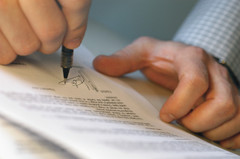EDITOR’S NOTE: This post has been updated. Click here to read the most current version.
1. Bring a cashier’s check. A good lender will do everything in their power to provide escrow with instructions in a timely manner so that they can, in turn, give you the dollar amount required as soon as possible. Sometimes, you may only get a day or two of notice before escrow contacts you with this information. The reason this can occur so late in the process is because all the loan documents have to be prepared by the lender and are then delivered to the escrow company with our instructions. The escrow company then creates a HUD-1 Settlement Statement which determines exactly how much funds you need to bring to closing. When you are told the amount, you need to obtain a cashier’s check payable to the escrow company and bring it with you to the closing appointment. A personal check is a no-no. NOTE: If you are considering wiring funds to the escrow company, please contact them in advance to discuss this process.
2. Bring a copy of your Good Faith Estimate. You will want to compare it to the Estimated HUD-1 Settlement Statement that will be presented to you at the signing. Hopefully, the Escrow Officer has provided your Loan Originator a copy of the HUD in advance for them to review it prior to your appointment.
3. Bring your current driver’s license. The notary must see them for proof you are you! Some may require two forms of identity.
4. Bring anything else that the escrow company or lender request. Sometimes the lender may need you to bring follow up documentation to closing (such as originals, paystubs, etc.).
5. Bring directions to the escrow company. Be sure to get specific directions to the escrow company from the escrow company (or visit www.mapquest.com). Please be on time. Escrow companies are often very busy and generally on time.
6. Plan on your signing taking approximately 45 – 60 minutes. If you would like to have more time to read your documents, or to have an attorney review them for you, ask your lender in advance so they can accommodate having a copy of your loan documents available to you in advance. Your loan package is about an inch of paper. If you want to read it word for word, you should get a copy beforehand.
7. Sign your documents as your names appear. Sign your name within the County’s required borders for recordings. This avoids last minute corrections or delays in your closing. You may want to do some hand exercises before signing (just teasing—well, kind of).
If you have questions regarding your loan documents or program, please call your Loan Originator. Don’t be shy! The signer may not be familiar with your specific loan program.
After signing your documents, escrow sends the original required documents to the title company who, after reviewing, delivers them to the County. With our company, the funding department also reviews the loan documents and verifies all conditions are met.
At this point, the lender coordinates with the escrow company to release the funds and to record the documents on the scheduled day for closing. Typically either the escrow company or your real estate agent will contact you once your transaction has recorded.











Just studying blogging and found this site. Thank you.
Thanks, John. I hope you found it useful. Are you taking Jillayne Schlicke’s class?
NOTE: It’s also perfectly fine to wire your funds to the escrow/closing company. Do check with them first to get wire instructions.
Hi Rhonda,
Can the dollar amounts like the payoff amount, change from the time documentas are signed and the closing of the loan?
Pedro, it’s possible that prorated interest may change.